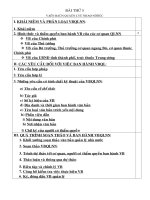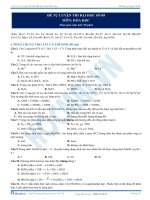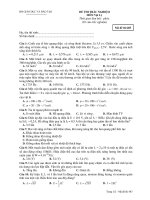PASSAGE 5
Bạn đang xem bản rút gọn của tài liệu. Xem và tải ngay bản đầy đủ của tài liệu tại đây (59.06 KB, 4 trang )
PASSAGE 5
For many years, scientists have speculated that the cataclysmic impact of an asteroid with the earth was
responsible for the demise of the dinosaurs approximately 65 million years ago. Previous discoveries and
results have hinted that an asteroid two kilometers in diameter struck the Yucatan peninsula in Eastern
Mexico. This impact, stronger than one thousand nuclear explosions, is speculated to have cast a cloud of
dust and debris into the atmosphere, covering the entire surface of the earth and blocking out the sun and
consequently lowering the surface temperature of the earth. With such a radical change in the earth’s
environment, scientists believe that over 99% of all animal and plant species were eradicated. Only after
millions of years did plants and animals even begin to recover and develop into forms that were better
adapted to survive changes in their environment. But, the reign of the dinosaurs had ended and the age of
mammals had begun.
The crucial link that has held this theory together has been the element iridium. Iridium is not commonly
found on either the surface of the earth or inside the crust. It is more commonly found in asteroids or
meteorites throughout the solar system. Scientists have hypothesized that after the asteroid impacted the
earth, an even layer of iridium sediment settled over the globe and eventually became part of its surface.
The theory, of course, has depended on the discovery of such an existing layer of iridium.
Unfortunately, scientists have never been able to offer absolute proof that this asteroid impact ever
occurred. Recently, however, a discovery may go a long way toward validating these scientists’ theories.
In 1996, a team of marine biologists excavated samples of rock from the Atlantic Ocean just off the cost
of Bermuda. Found thousands of meters below the sea, these samples contain iridium similar to those
found in the Yucatan peninsula thousands of kilometers away. At first, scientists were skeptical whether
the samples were from the same time period. But since carbon dating placed them to 65 million years ago,
their doubts were quickly alleviated. Since then many of the other theories for the demise of the dinosaur
have been finally laid to rest.
Question 1. According to the passage, approximately how large was the asteroid that scientists believe
struck the Earth?
A. 2 kilometers in diameter
B. 65 kilometers in diameter
C. 1000 kilometers in diameter
D. 99 kilometers in diameter
Question 2. The word “hinted” is closest in meaning to ___________
A. disproved
B. flirted
C. denied
D. implied
Question 3. The word “cast” is closest in meaning to ___________.
A. shone
B. climbed
C. dispersed
D. excused
Question 4. What can be inferred from the passage about asteroid impact mentioned in lines 6 – 8?
A. New plants and animals evolved with the changed environment.
B. The gravitational force from the earth’s core is altered.
C. A planetary defense system formed.
D. The climate remained fairly constant.
Question 5. The word “reign” is closest in meaning to ___________.
A. understanding
B. dominance
C. denial
D. extremity
Question 6. The word “It” in line 10 refers to ___________.
A. crust
B. asteroid
C. earth
Question 7. What does fourth paragraph of the passage mainly discuss?
D. iridium
A. The major processes that have created the Earth’s crust.
B. The composition of the ocean floor in the Atlantic Ocean.
C. Recent discoveries that may confirm the asteroid impact hypothesis.
D. The discovery of ancient fossils located far beneath the ocean floor.
Question 8. According to the passage, the iridium found beneath the ocean floor near Bermuda
___________
A. can be refined into fossil fuels.
B. is similar to the iridium found on the Yucatan peninsula.
C. originated from dinosaur remains.
D. was chemically manufactured by miners
Question 9. The paragraph following the passage probably discusses ___________
A. the relationship between volcanic activity and dinosaur extinction.
B. why dinosaurs lived where they did.
C. recent computer imagery of dinosaur movement.
D. the possibility of a future asteroid impact.
Question 10. This passage mainly discusses a theory about ___________.
A. which type of dinosaur roamed freely
B. archeological evidence from Mexico and the Atlantic Ocean
C. why the dinosaurs turned into birds and reptiles
D. the extinction of the dinosaurs
ĐÁP ÁN
1-A
2-D
3-C
4-A
5-B
6-D
7-C
8-B
9-D
10-D
LỜI GIẢI CHI TIẾT
Question 1:
2 kilometers in diameter
Đoạn sau trong bài cho thấy kích cỡ của hành tinh đã va chạm vào trái đất: “ Previous discoveries and
results have hinted that an asteroid two kilometers in diameter struck the Yucatan peninsula in Eastern
Mexico.”
(Các phát hiện và kế quả trước đây đã ngụ ý rằng một hành tinh nhỏ đường kính 2km đã vao vào bán đảo
Yucatan ở Đơng Mexico)
Question 2:
implied = hinted = ngụ ý.
Question 3:
dispersed = phân tán, đồng nghĩa với cast (thả, ném)
Question 4:
Dòng 6 – 8: “With such a radical change in the earth’s environment, scientists believe that over 99% of all
animal and plant species were eradicated. Only after millions of years did plants and animals even begin
to recover. But, the reign of the dinosaurs had ended and the age of mammals had begun.” (Với sự thay
đổi sâu sắc như thế trong môi trường trên trái đất, các nhà khoa học tin rằng hơn 99 % các loài động, thực
vật đã bị tiêu diệt. Chỉ sau khi hàng triệu năm, các loài động vật và thực vật mới bắt đầu phục hồi. Tuy
nhiên, sự thống trị của loài khủng long đã chấm dứt và thời đại của động vật có vú bắt đầu. )
Question 5:
Giải thích: Từ “reign” gần nghĩa nhất với ………………………………………..
Ta có: reign (n) = dominance (n): sự thống trị
Các đáp án còn lại:
understanding (n): sự thấu hiểu
denial (n): sự phủ nhận, lời phủ nhận
extremity (n): sự bất hạnh tột độ, cảnh túng quẫn
Question 6:
Dòng 10: “Iridium is not commonly found on either the surface of the earth or inside the crust. It is more
commonly found in asteroids or meteorites throughout the solar system.” (Iriđi thường khơng được tìm
thấy cả ở bề mặt và bên trong vỏ Trái đất. Nó thường thấy nhiều hơn trong các tiểu hành tinh hoặc thiên
thạch nằm trong hệ mặt trời.) Vậy “It” là đại từ thay thế cho “Iridium
Question 7:
Câu thứ 2 là câu chủ đề của đoạn 4: “Recently, however, a discovery may go a long way toward
validating these scientists’ theories.” (Tuy nhiên, gần đây, một phát hiện đã có thể góp phần lớn vào việc
chứng thực giả thuyết này của các nhà khoa học.)
Các câu tiếp theo mô tả phát hiện các mẫu đá năm 1990 giống như ở bán đảo Yucatan và việc chứng minh
được chúng tồn tại cùng thời điểm. Điều này khẳng định giả thuyết “va chạm của tiểu hành tinh” là đúng
đắn.
Question 8:
is similar to the iridium found on the Yucatan peninsula.
Đoạn sau trong bài đưa ra thông tin về nguyên tố Iriddi được tìm thấy ở dưới lịng đại dương gần
Bermuda: “In 1996, a team of marine biologists excavated samples of rock from the floor of the Atlantic
Ocean just off the coast of Bermuda. Found thousands of meters below the sea, these samples contain
iridium similar to those found in the Yucatan peninsula thousands kilometers away.”
(Năm 1996, một nhóm các nhà hải dương học đã khai quật được các mẫu đá từ lịng Đại Tây Dương chỉ ở
ngồi bờ biển Bermuda. Được tìm thấy từ hàng ngàn mét dưới biến, những mẫu vậ này có chứa nguyên tố
Iridium tương tự với mẫu vật được tìm thấy ở bán đảo Yucatan cách đó hàng ngàn km.)
Question 9:
The possibility of a future asteroid impact
Câu cuối bài gợi mới về nội dung có thể được nói đến ở đoạn văn kế sau:” Since then many of the other
theories for the demise of the dinosaur have been finally laid to rest.”
(Kể từ đó rất nhiều các giả thuyết khác về sự diệt chủng của loài khủng long cuối cùng đã được đưa ra.)
Question 10:
Câu đầu tiên là câu chủ đề của toàn bài: “For many year, scientists have speculated that the cataclysmic
impact of an asteroid with the earth was responsible for the demise of the dinosaurs approximately 65
million years ago.” (Trong nhiều năm, các nhà khoa học đã suy đoán rằng các tác động gây ra đại hồng
thủy của một tiểu hành tinh lên Trái đất đã dẫn đến sự tuyệt chủng của loài khủng long cách đây khoảng
65 triệu năm.)
Các câu văn tiếp theo làm sáng tỏ cho câu chủ đề bằng giả thuyết về “impact of an asteroid with the
earth” sự va chạm của một tiểu hành tinh vào Trái đất) và các bằng chứng xoay quanh nó.
Bài dịch
Trong nhiều năm, các nhà khoa học đã suy đoán rằng các tác động gây ra đại hồng thủy của một tiểu hành
tinh lên Trái đất đã dẫn đến sự tuyệt chủng của loài khủng long cách đây khoảng 65 triệu năm. Những
cuộc khám phá và kết quả trước đây đã gợi ý rằng một tiểu hành tinh có đường kính 2 km đã va vào bán
đảo Yucatan phía đơng Mexico. Cuộc va chạm này, mạnh hơn một nghìn vụ nổ hạt nhân, được đoán là đã
thải ra một đám mây bụi và mảnh vỡ vào bầu khí quyển, bao phủ toàn bộ bề mặt của Trái đất . Với sự
thay đổi sâu sắc như thế trong môi trường trên trái đất, các nhà khoa học tin rằng hơn 99 % các loài động,
thực vật đã bị tiêu diệt. Chỉ sau khi hàng triệu năm, các loài động vật và thực vật mới bắt đầu phục hồi.
Tuy nhiên, sự thống trị của loài khủng long đã chấm dứt và thời đại của động vật có vú bắt đầu.
Những mắt xích quan trọng trọng đã tạo ra giả thuyết này là ngun tố iriddi. Iriđi thường khơng được
tìm thấy cả ở bề mặt và bên trong vỏ Trái đất. Nó thường thấy nhiều hơn trong các tiểu hành tinh hoặc
thiên thạch nằm trong hệ mặt trời. Các nhà khoa học đã đưa ra giả thuyết rằng sau khi tiểu hành tinh va
chạm vào Trái đất, một lớp trầm tích irđi bằng phẳng đã bao phủ khắp Địa cầu và cuối cùng trở thành một
phần của bề mặt Trái đất . Dĩ nhiên, các giả thuyết đã dựa vào việc phát hiện ra như một lớp iriddi đang
hiện hữu như thế.
Thật không may, các nhà khoa học chưa bao giờ có thể cung cấp bằng chứng chính xác rằng vụ va chạm
thiên thạch này đã từng xảy ra. Tuy nhiên, gần đây, một phát hiện đã có thể góp phần lớn vào việc chứng
thực giả thuyết này của các nhà khoa học. Năm 1996, một nhóm các nhà sinh học biển đã khai quật được
những mẫu gần bờ biển Bermuda. Được tìm thấy ở độ sâu hàng ngàn mét dưới đại dương, những mẫu đá
đó chứa iriđi tương tự như những mẫu đá nằm ở bán đảo Yucatan cách đó hàng ngàn km. Lúc đầu, các
nhà khoa học cịn hồi nghi liệu rằng các mẫu đá này có ở cùng một thời điểm không. Nhưng kể từ khi
phương pháp xác định niên đại bằng cac-bon đã xác định là từ 65 triệu năm về trước, những nghi ngờ của
họ đã nhanh chóng dịu đi. Kể từ đó nhiều giả thuyết khác về sự tuyệt chủng của lồi khủng long đã bị
chơn vùi .









